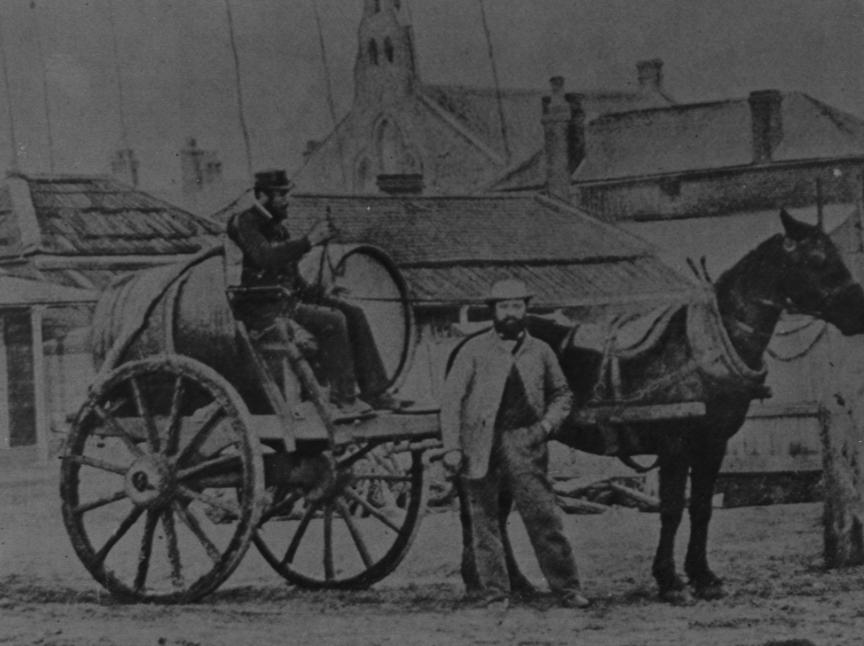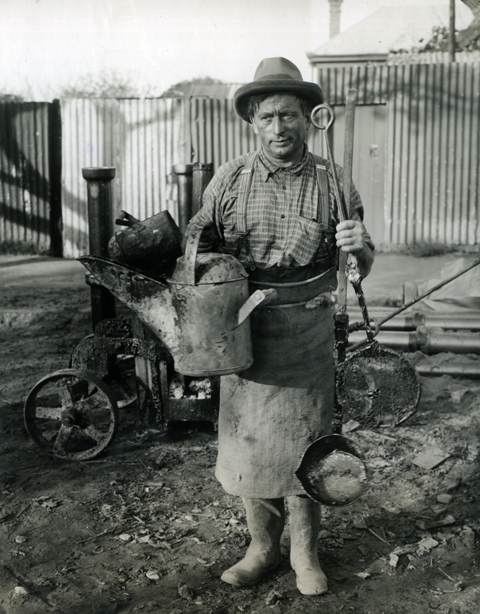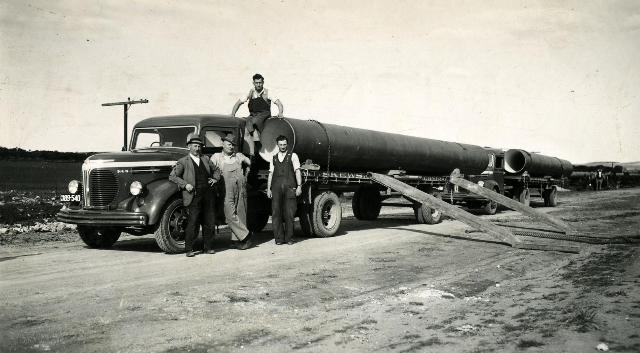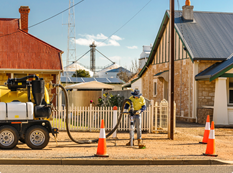Our 160+ year journey
Our 160+ year journey
Our long history of service to South Australia began in 1856 and has four chapters.
The first was fixing water supply to a fledgling colony. The second was removing waste, leading to the third - treatment and reuse of sewage. And the fourth chapter, which we are living now, covers innovation in production and the re-use of water.
Chapter 1: From Settlement to Piped Water (1836 – 1862)
 When settled in 1836, the only real water source for Adelaide was the River Torrens. The river became problematic as it was used not only as drinking water, but water-for-all-purposes including waste disposal. Water carting from the river to homes was big business. Disease quickly spread: dysentery was rife in Adelaide's early years and clean water was urgently needed. In 1856, the earliest version of our organisation was set up: the Waterworks & Drainage Commission. The commission needed to solve the water supply and sewerage problems of the city. By 1860, the first supplies of reticulated water reached Adelaide homes from the Kent Town Valve House. In 1862, the first reservoir water was piped from Thorndon Park Reservoir.
When settled in 1836, the only real water source for Adelaide was the River Torrens. The river became problematic as it was used not only as drinking water, but water-for-all-purposes including waste disposal. Water carting from the river to homes was big business. Disease quickly spread: dysentery was rife in Adelaide's early years and clean water was urgently needed. In 1856, the earliest version of our organisation was set up: the Waterworks & Drainage Commission. The commission needed to solve the water supply and sewerage problems of the city. By 1860, the first supplies of reticulated water reached Adelaide homes from the Kent Town Valve House. In 1862, the first reservoir water was piped from Thorndon Park Reservoir.
Chapter 2: Problems of Supply and Sewage (1863 – 1938)
 In the 40 years between 1862 and 1903, five more reservoirs were built. In that time, Adelaide's population reached 200,000 and sewage management was an increasing issue.
In the 40 years between 1862 and 1903, five more reservoirs were built. In that time, Adelaide's population reached 200,000 and sewage management was an increasing issue.
The Deep Drainage Network was started. By 1881, that system became functional and we became the first city in Australia to use a water-based sewerage system.
In 1920, five years after the first major drought (1914-15), a series of locks and weirs along the River Murray was started. They were designed to keep the river at consistent levels and took 10 years to complete.
In 1929, the Waterworks & Drainage Commission became the Engineering & Water Supply Department (E&WS).
While water supply was still a focus, sewerage and drainage works were keeping pace with each other. In 1938, during the Great Depression, two significant milestones were reached: South Australia's largest reservoir opened at Mount Bold and most of Adelaide was connected to sewerage.
The Mount Bold Reservoir covered 308 hectares. From 1938 to 1961, it was powered by a small hydro-electricity plant.
Chapter 3: From supply to security: water for the future (1939 – today)
Major pipelines have been an important part of our history. In 1944, the Morgan to Whyalla pipeline was completed. Just over 10 years later, in 1956, River Murray water reached the suburbs when the Mannum to Adelaide pipeline was finished.
By 1955, Adelaide became the first Australian city to have 75% of its suburbs connected to the sewers. Then, in 1966, the Bolivar Treatment Works opened.
In 1976, the first Water Resources Act was implemented in South Australia. Now adapted to meet today's needs, the Act ensures water resources are managed for the benefit of South Australians.
Between 1976 and the late 1990s, a series of filtration and treatment plants were built and began operating. Then, in 1995, the State Water Laboratory and the Australian Centre for Water Quality Research were combined to form the Australian Water Quality Centre (AWQC). The AWQC is now recognised as one of the best water quality testing services in Australia.
Chapter 4: Technology and a changing environment (1999 – today)
In 1999, a desalination plant opened at Penneshaw on Kangaroo Island, ending its lack of state-supplied water. In the same year, the Virginia Pipeline Scheme was finished. This became the first – and largest – reclaimed water scheme of its type in Australia.
By our 150th anniversary in 2006, we were continuing to focus on the security of water supply for South Australia. This became vital during the Millennium Drought (2002-2007). Living in the driest state, on the driest inhabited continent, means water supplies can be a big issue.
In 2007, plans to build the Adelaide Desalination Plant were announced. By October 2011, it was producing and delivering drinking water to our customers, and insuring the state against future drought.
The role of the River Murray
 The River Murray is an ancient river.
The River Murray is an ancient river.
The history of the river itself stretches back more than 60 million years. It has existed since Australia split from the giant super continent, Gondwanaland.
Aboriginal peoples have occupied the river valley for at least 40,000 years. The river plays a major role in Aboriginal Dreaming stories. According to the Ngarrindjeri, the Murray was just a stream. It became the mighty river we know today when local 'hero' Ngurunderi chased a giant cod (Ponde). As the fish swam ahead of Ngurunderi, it widened the river with sweeps of its tail. When Ngurunderi got to Tailem Bend (Tagalang), he threw a spear at the giant fish. The spear caused the cod to surge ahead of Ngurunderi, creating a long, straight stretch in the river.
European interaction with the river began in 1832, when explorer Charles Sturt wrote an account of his trip. The River Murray was central to trade in the 1800s - cargo carried upstream by paddle steamers went to settlers and miners in the Victorian goldfields. Cargo carried downstream was produce from outlying areas: wool, wheat, hides, salt and oats.
The river flow was regulated by the construction of storages, locks and weirs. Six were built in South Australia in the 1920s and 1930s. At the river mouth, five barrages were built across the channels leading from Lake Alexandrina. The barrages prevent seawater entering the lakes system during periods of low river flow.
The significant contribution of the locks to the state's development has been irrigation and navigation. River water has turned populated areas along its banks into thriving townships. Orchards of citrus and stone fruit, and grapes and vegetables benefit from the water. A consistently navigable passage down the river has also seen tourism boom.
Sustainable management of the River Murray is critical if South Australia's development is going to continue. We need to improve the health of the Murray, because it's a unique ribbon of life for South Australia.
Our history - in pictures
We have a comprehensive library of historical images on our Flickr site. Images are available to use under Creative Commons licensing. You can view the library here.
Major faults
Polkinghorns Rd
Arthurton
- 18/06/2020
Water Supply On
- 18/06/2020 03:05 PM - We are attending to an incident in Arthurton with no interruption to the water supply. The safety of our crews and customers comes first, and we always aim to minimise inconvenience by restoring services as quickly as we can. Reference Number WO: 07505663.
- See all major faults
Scheduled works
Spruance Rd
Elizabeth East
- 11/06/2021
Temporary Supply Interruption
- Estimated start time and water supply off: 15/06/2021 09:00 AM
Estimated restore time and water supply back on: 15/06/2021 04:00 PM
We’re improving your services and undertaking maintenance work in Elizabeth East. Sometimes our crews need to temporarily interrupt the water supply to our customers and/or manage traffic while they are working. Temporary traffic management may remain in place until reinstatement of the impacted road is complete. We always aim to minimise inconvenience by restoring services as safely and quickly as we can. - See all scheduled works









